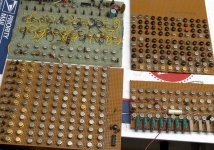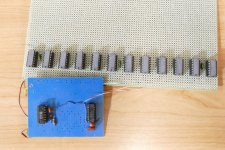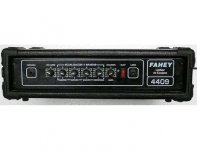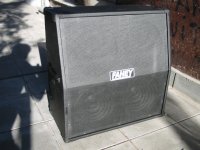Your cat survived the fire?
Family, kids lived in a different place?
I always unplug irons after work, seen too many fires caused by stupidity, or effect of drugs / alcohol.
And ice water or ice is the best first treatment for burns, apply till you feel the cold.
Family, kids lived in a different place?
I always unplug irons after work, seen too many fires caused by stupidity, or effect of drugs / alcohol.
And ice water or ice is the best first treatment for burns, apply till you feel the cold.
Last edited:
You know they have "7 lives"Your cat survived the fire?
I asked about him, firemen told me a small grey cat came out running "like a bat out of hell" ... which was not far from the truth, and hid at a neighbour´s house across the street.
When I picked him up, he still smelled "smoky".
Oh well.
No family/kids yet, I married late.Family, kids lived in a different place?
Quite the OCD type dedicated to Electronics and Manufacturing, you know the type, quite common in this trade.
I know a guy doing work for a gal who had parked her lawn tractor in the garage and it burned down. (Muffler spark.)
The homeowner insurance company gave her a VERY hard time, because they found art supplies in the ashes, asked around, she had sold a painting. Just one, for a very small amount, but they said "Business!" and declined to pay out.
Which was silly and they knew it. Every 3rd person here "paints". Some of them show. Sometimes their works sell. Never for what the time and supplies cost, but a sale is a thrill.
She was outraged. She had the wealth to get a lawyer outraged for her. And an accountant to show her HOBBY could not be qualified as a Business under applicable tax and business laws. Faced with a 50:50 chance of paying treble damages, the insurance offered most of the cost of a garage and she settled. So the guy I know went over and built the garage.
The homeowner insurance company gave her a VERY hard time, because they found art supplies in the ashes, asked around, she had sold a painting. Just one, for a very small amount, but they said "Business!" and declined to pay out.
Which was silly and they knew it. Every 3rd person here "paints". Some of them show. Sometimes their works sell. Never for what the time and supplies cost, but a sale is a thrill.
She was outraged. She had the wealth to get a lawyer outraged for her. And an accountant to show her HOBBY could not be qualified as a Business under applicable tax and business laws. Faced with a 50:50 chance of paying treble damages, the insurance offered most of the cost of a garage and she settled. So the guy I know went over and built the garage.
After working in a lab for a bit I learned not to try to catch anything that fell off the table. Actually we were trained to jump away from anything falling. Tools are easily replaced. Body parts, not so much.
I have been a barefoot person since growing up in Miami in the days when only rich people had air conditioning. You don't need training, when something falls you jump back. By a young age it was a learned reflex action.
Despite protests from the safety police I wore flip flops to work for most of my 41 years of working at Motorola. I did keep a pair of old moccasins under my desk when I worked in the factory for the few times an OHSA or other inspector was present. Moccasins are as good as nothing in terms of foot protection, but nothing bad ever happened.
Shoes and long thick jeans are recommended when removing parts from scrap boards using a heat gun or Propane torch and a pair of Vise Grips. I used the get the board smoking, then smack it on the table method.....let the parts cool before picking them up!
.......Moccasins are as good as nothing in terms of foot protection....
They keep the loose toes together. If you leave any behind they draw vermin.
Oh, the old "burn and slap" method!!.... removing parts from scrap boards using a heat gun or Propane torch and a pair of Vise Grips. I used the get the board smoking, then smack it on the table method.....let the parts cool before picking them up!
In the very early days, I used to buy old IBM mainframe boards "by the kilo" at a surplus dealer, melt solder side wih a small propane torch and slap against a newspaper covered table .... hundreds of TO5 transistors, thousands of mystery diodes in glass case, think 1N4148 or similar and resistors in weird useless values.
Tons of ceramic caps also.
Guess they were discrete DTL Logic or something.
The real prize were transistors and ceramics, everything else never fit my projects.
Later on, of course, it became cheaper/easier to plain buy fresh stuff although today still pull relays and a couple supply caps from stuff before junking, or MJE13007 class switching transistors from CFL lamps or ferrite transformers from PC supplies, I made a small PCB to drive them with IRS2153 which is a Godsend to me.
All of these round metal and plastic covered ceramic parts are RTL IC chips from the late 60's. Each can is a single logic gate or a single flip flop.
All were obtained by burning them off of medical electronics boards obtained from the trash dumpster at Coulter Diagnostics in Hialeah Florida back in the 60's. They are still there today.
Note the pattern of 12 identical circuits. There are 12 notes in a musical octave. This was my 1970 attempt to build a digital music synthesizer. It was making some music when personal circumstances changed and the project was abandoned. I kept these boards since it took me nearly a year to make them.
All were obtained by burning them off of medical electronics boards obtained from the trash dumpster at Coulter Diagnostics in Hialeah Florida back in the 60's. They are still there today.
Note the pattern of 12 identical circuits. There are 12 notes in a musical octave. This was my 1970 attempt to build a digital music synthesizer. It was making some music when personal circumstances changed and the project was abandoned. I kept these boards since it took me nearly a year to make them.
Attachments
JM,
"FWIW my amps are currently being exhibited at the National Senate building, which is holding a "50 years of Argentine Rock" event, as "THE Amps used by Argentine Rock Musicians", go figure".
That's pretty impressive. National recognition. You could be very proud of achieving such in a life and that would be A-OK! Any performances during the exhibit?
It would be cool if one of those Argentinean guitar gods dropped in for an afternoon, turned those baby's on and shredded that place down!
"FWIW my amps are currently being exhibited at the National Senate building, which is holding a "50 years of Argentine Rock" event, as "THE Amps used by Argentine Rock Musicians", go figure".
That's pretty impressive. National recognition. You could be very proud of achieving such in a life and that would be A-OK! Any performances during the exhibit?
It would be cool if one of those Argentinean guitar gods dropped in for an afternoon, turned those baby's on and shredded that place down!
Shoot, George, I hadnt even found any of Don Lancaster's books yet in 1970. I remember the CMOS cookbook where he described the MK50240 top octave generator. The grandest thing I ever did with that was put it in a PLL and try to lock it to my electric guitar note - it yielded a synth that could play in harmony with 1/2 step digital precision. Got me a good grade for an EE elective.
But I wasnt like you; I wasnt about to pay for a hexaphonic pickup and then build six such circuits, each optimized to chase the frequency range of an individual string...
But I wasnt like you; I wasnt about to pay for a hexaphonic pickup and then build six such circuits, each optimized to chase the frequency range of an individual string...
Thanks 
That was the original idea, we lost a couple (drugs, HIV, Harley chopper accident, not kidding) yet many are still around but given the current COVID restrictions the Live part was dropped.
But maybe in a year or two it´s repeated and then, who knows?
A couple free samples:
1) don´t even TRY to listen to this one, it´s a heavily distorted bootleg recorded on a portable cassette recorder, completely unable to handle Live show SPL, just browse images as in a slide show, you´ll see the typical 70s to 90s Argentine Rock stage backup: ALL or 90% "Faheys" (even the amp driving the Leslie rotary speaker cabinet, plus Keyboard mixer/Power amps/cabinets) with a lonely Fender Twin for the Guitar player.
La Maquina de Hacer Pajaros en vivo 7 Agosto 1976 - YouTube
2) for a "listenable" Audio sample, here´s the vinyl recording:
Que Se Puede Hacer Salvo Ver Peliculas - YouTube
mind you, that was the height of the "Progressive Rock" era, and in general we are way more British/European influenced than "American Rock".
Think Premiata Forneria Marconi / Focus / British Progressive rather than Kiss or Van Halen.
That was the original idea, we lost a couple (drugs, HIV, Harley chopper accident, not kidding) yet many are still around but given the current COVID restrictions the Live part was dropped.
But maybe in a year or two it´s repeated and then, who knows?
A couple free samples:
1) don´t even TRY to listen to this one, it´s a heavily distorted bootleg recorded on a portable cassette recorder, completely unable to handle Live show SPL, just browse images as in a slide show, you´ll see the typical 70s to 90s Argentine Rock stage backup: ALL or 90% "Faheys" (even the amp driving the Leslie rotary speaker cabinet, plus Keyboard mixer/Power amps/cabinets) with a lonely Fender Twin for the Guitar player.
La Maquina de Hacer Pajaros en vivo 7 Agosto 1976 - YouTube
2) for a "listenable" Audio sample, here´s the vinyl recording:
Que Se Puede Hacer Salvo Ver Peliculas - YouTube
mind you, that was the height of the "Progressive Rock" era, and in general we are way more British/European influenced than "American Rock".
Think Premiata Forneria Marconi / Focus / British Progressive rather than Kiss or Van Halen.
Recently, I was in a hurry and angry. Without knowing I misplaced my left foot on the top stair, my foot slipped with the result my entire body slipped almost halve the entire staircase. The result was a horrible skin abrasion just above my left ankle, a large blue and hard bruise at the left hipjoint and a slight injury near the right wrist. To literally add insult to injury, I used hydrogen peroxide on the skin abrasion above the ankle, and the result, was a deep burn which took weeks to heal! I remember the nurse calling at my home to change the dressings and the intense itching and burning I had to endure.
Serves me right! Needless to state, I learnt my lesson; staircases can be treacherous.
Serves me right! Needless to state, I learnt my lesson; staircases can be treacherous.
I remember the CMOS cookbook where he described the MK50240 top octave generator. The grandest thing I ever did with that was put it in a PLL and try to lock it to my electric guitar note - it yielded a synth that could play in harmony with 1/2 step digital precision. Got me a good grade for an EE elective.
The two boards on the left are top octave generators with 2 (green board) and 5 (brown board) octaves of frequency dividers added. The green one used a less optimum set of divide ratios limited by the maximum divide ratio of 256 in an 8 bit counter. It worked and sounded sort of OK when played by itself. When accompanied by any properly tuned instrument it sounded sick. The brown board used 9 bit dividers like the original Mostek MK5024 (predecessor of the 50240). It's problem was the maximum clock speed of the 60's vintage RTL logic chips which were rated at 1 MHz.
The small board on the lower left simply used 12 tunable oscillators with three sets of octave dividers. The other board is a system of gates that are switched by the keyboard.
I experimented with the MC4046PLL, but I made more noise than music with that one. That was before you could get a divided pickup, and before I learned how to make them. A PLL goes nuts when you feed it two simultaneous notes.
I went a different route with a "wired" neck. A friend in the late 70's patented (long expired) a fretboard that IS a PC board. It's still in a box here somewhere......maybe someday I'll dig it out and swap all of my complicated logic and analog circuitry for a CPU and a DAC.
By about 1980 you could buy this "Top Octave Experimenter" board from PAIA I think. It and 12 divider chips made like 10 or 12 octaves of tones. I still have some of those MK50240 chips somewhere, but today all of this can be done in a PIC chip
Attachments
The video doesn't do your equipment justice, so I hope you won't mind me appending a couple of clearer images from the interweb....you´ll see the typical 70s to 90s Argentine Rock stage backup: ALL or 90% "Faheys" (even the amp driving the Leslie rotary speaker cabinet, plus Keyboard mixer/Power amps/cabinets).
Attachments
I've done the grabbing the wrong end of the soldering iron thing a few times. The internal debate deciding whether to jump out of the way of something you've dropped or to jam the legs together is an interesting dilemma. Particularly if it's hot or sharp and delicate.
IIRC, there's a scene in Tom Sawyer where the eponymous hero is pretending to be a girl, but is caught out by a woman who deliberately throws him something he can't catch with his hands. Sawyer puts his legs together to catch it. Apparently, according to Sam Clemens, girls naturally move their legs apart to avoid getting hit. So Sawyer is revealed...
IIRC, there's a scene in Tom Sawyer where the eponymous hero is pretending to be a girl, but is caught out by a woman who deliberately throws him something he can't catch with his hands. Sawyer puts his legs together to catch it. Apparently, according to Sam Clemens, girls naturally move their legs apart to avoid getting hit. So Sawyer is revealed...
Well, yes. 
Way back then, girls used skirts, so increasing the catch area was the way to go.
Boys of course had to try to grab it as it went by.
There must be a zillion actions which we call "natural" or even worse, argue or fight others because "they do it the WRONG way", which in fact become custom for practical reasons.
* Thanks Galu
Way back then, girls used skirts, so increasing the catch area was the way to go.
Boys of course had to try to grab it as it went by.
There must be a zillion actions which we call "natural" or even worse, argue or fight others because "they do it the WRONG way", which in fact become custom for practical reasons.
* Thanks Galu
>I experimented with the MC4046PLL, but I made more noise than music with that one. That was before you could get a divided pickup, and before I learned how to make them. A PLL goes nuts when you feed it two simultaneous notes.
As I recall, it also goes nuts when you feed it a note with lots of harmonics. I had to learn to play the guitar always plucking the string dead center of whatever length I was fretting. I went as far as putting a tracking bandpass filter on the guitar signal, set to the current PLL frequency. Well, at least approximately...
Then I heard Jerry Garcia play though the "360 Systems" synth and it just broke my heart that I couldnt even come close to that thing's note tracking performance. So I took the elective "A" grade from the prof who was into analog and abandoned it.
"The company's founder, Californian Bob Easton, was an acquaintance of Tom Oberheim and the two collaborated on some pitch converter designs circa 1975. 360's first product, introduced around 1977, was the Slavedriver, a pitch-to-CV/gate converter that, in theory, could be used with any instrument and would control an analog synthesizer with CV/gate inputs".
I still sometimes wonder how they did it. The article I quoted above later mentioned that NO guitar synth company got the tracking good enough to make sales (ARP). I disagree - look at Roland!
As I recall, it also goes nuts when you feed it a note with lots of harmonics. I had to learn to play the guitar always plucking the string dead center of whatever length I was fretting. I went as far as putting a tracking bandpass filter on the guitar signal, set to the current PLL frequency. Well, at least approximately...
Then I heard Jerry Garcia play though the "360 Systems" synth and it just broke my heart that I couldnt even come close to that thing's note tracking performance. So I took the elective "A" grade from the prof who was into analog and abandoned it.
"The company's founder, Californian Bob Easton, was an acquaintance of Tom Oberheim and the two collaborated on some pitch converter designs circa 1975. 360's first product, introduced around 1977, was the Slavedriver, a pitch-to-CV/gate converter that, in theory, could be used with any instrument and would control an analog synthesizer with CV/gate inputs".
I still sometimes wonder how they did it. The article I quoted above later mentioned that NO guitar synth company got the tracking good enough to make sales (ARP). I disagree - look at Roland!
Last edited:
Interesting interview with the Easton guy ~ mid 70's. Sounds like it could have been any one of us, but he got there first... Yes, there are people who are way better electrical engineers - who didnt even go to school for it!
https://monoskop.org/images/c/cf/Synapse_Vol_1_No_4.pdf
I liked Ah Te Vi Entre Las Luces! I could hear the PFM influences - whom I also like.
https://monoskop.org/images/c/cf/Synapse_Vol_1_No_4.pdf
I liked Ah Te Vi Entre Las Luces! I could hear the PFM influences - whom I also like.
- Home
- Member Areas
- The Lounge
- Not recommended.



